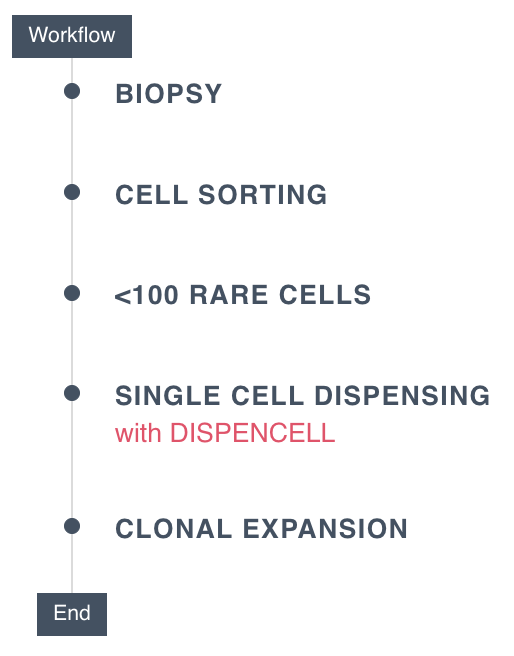
Rare cell isolation
Precious samples, no loss.
Cells of biomedical interest are often present in very small numbers within a much larger population of background cells. Seeding of target cell populations whose frequencies are less than 1%, such as circulating tumour cells, peripheral hematopoietic stem cells, foetal cells in maternal blood or antigen-specific lymphocytes, can be challenging using conventional cell seeding methods. Traditionally, rare cells are enriched using methods such as filter technologies, magnetic beads or fluorescent labels. Cell sorters such as FACS or microchip-based technology using enclosed cartridges are ideal methods to sort rare, targeted cells — equivalent to finding a few needles in a haystack. Designed to sort millions of cells in a short time, they usually have a large dead volume that makes them unsuitable for single cell seeding.
Workflow.
In such workflow, rare cells are first purified from biopsies using existing cell sorters. Even when the sorted sample is as small as 200 cells, DispenCell is used to handle the sample and seed the precious cells individually into wells for cell culture or omics assays.
Benefits.
DispenCell’s unique technology allows seeding of single rare cell samples down to 200 cells using pressure <0.2 psi, equivalent to manual pipetting. As a result, there is near-zero dead volume that enables sorting of a minimum input of 200 cells, while preserving the cells’ integrity and viability. This enables scientists to undertake new single-cell workflows on very rare and scarce samples from precious tissues.
Read how DispenCell operated in a rare cell isolation workflow with minimal cell loss in the application note.
Impedance-based pipetting of rare cells at single-cell resolution and minimal loss: from FACS to Dispencell
Garcia et al. Ecole Polytechnique Fédérale de Lausanne, Poster, Cyto 2019, Vancouver. Jun, 2019
Download
Thank you for your interest in this resource.
To download the resource, please complete your details.